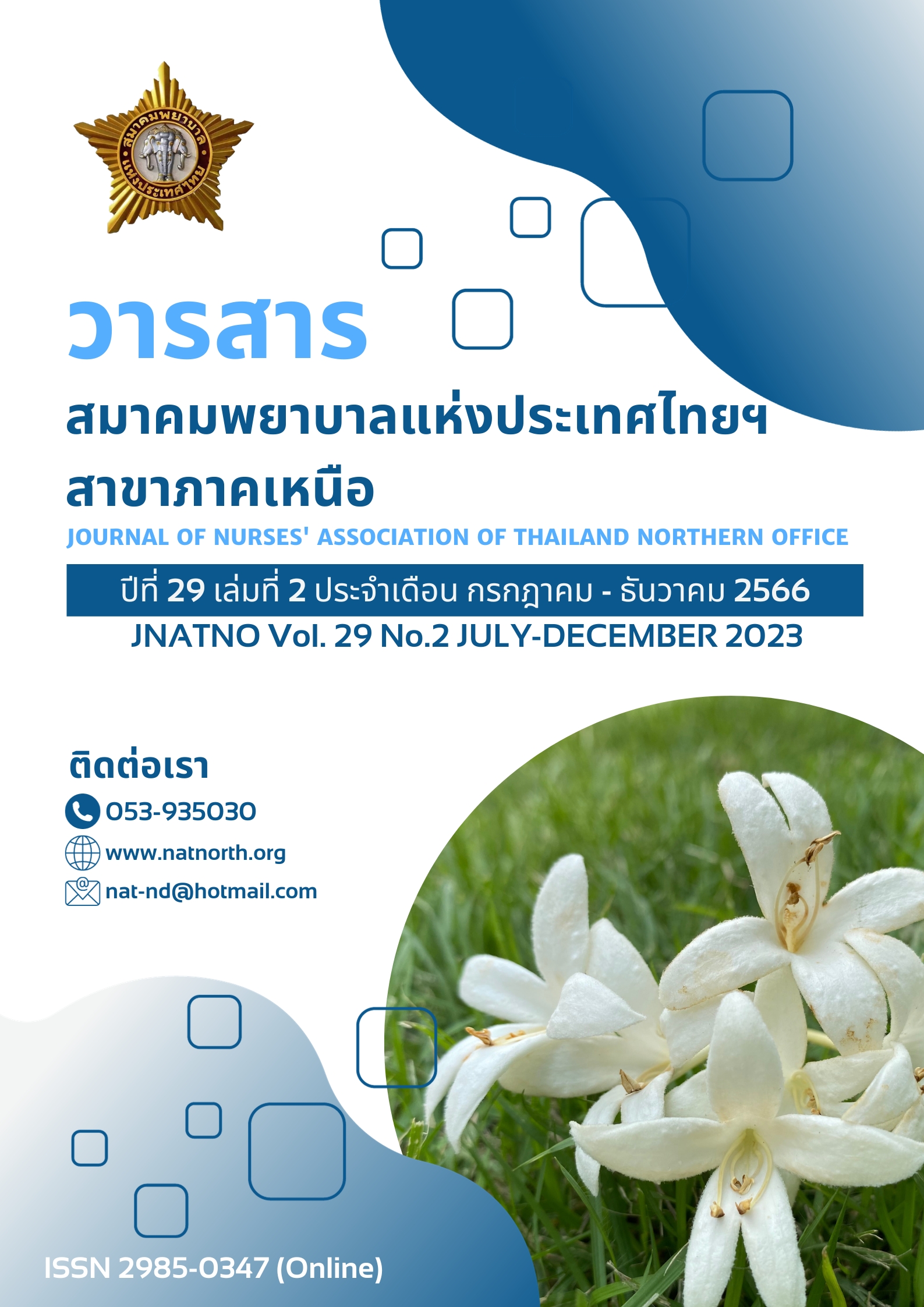The ปัจจัยที่ส่งผลต่อโรคแทรกซ้อนเรื้อรังของผู้ป่วยโรคเบาหวานในโรงพยาบาลส่งเสริมสุขภาพตำบลแห่งหนึ่งในจังหวัดนครปฐม
คำสำคัญ:
ผู้ป่วยเบาหวาน, ภาวะแทรกซ้อนเรื้อรัง, ปัจจัยที่มีผลต่อภาวะแทรกซ้อนเรื้อรังบทคัดย่อ
การวิจัยเชิงพรรณนานี้มีวัตถุประสงค์เพื่อศึกษาโรคแทรกซ้อนและปัจจัยที่ส่งผลต่อโรคแทรกซ้อนที่เกิดขึ้นกับประชากรที่เป็นโรคเบาหวานในโรงพยาบาลส่งเสริมสุขภาพตำบลแห่งหนึ่งในจังหวัดนครปฐม กลุ่มตัวอย่างคือผู้ป่วยโรคเบาหวานจำนวน 108 คน ที่ได้รับบริการที่โรงพยาบาลส่งเสริมสุขภาพตำบลแห่งหนึ่งในจังหวัดนครปฐม ได้มาโดยการคัดเลือกแบบเฉพาะเจาะจง เครื่องมือที่ใช้ในการวิจัยคือแบบสอบถามที่ผู้วิจัยสร้างขึ้นตามแนวคิดของโอเร็ม ได้รับการตรวจสอบความเที่ยงของเครื่องมือโดยการหาค่าสัมประสิทธิ์อัลฟาของครอนบาคได้ค่าเท่ากับ .93 แบบสอบถามประกอบด้วยคำถามเกี่ยวกับความรู้พื้นฐานเกี่ยวกับโรคเบาหวานและภาวะแทรกซ้อน การรับรู้หรือเจตคติเกี่ยวกับโรคเบาหวานและภาวะแทรกซ้อน การปฏิบัติในการดูแลตนเองของผู้เป็นเบาหวาน การสนับสนุนทางสังคม โดยใช้ลักษณะคำถามแบบมาตราส่วนประมาณค่าของลิเคิร์ท วิเคราะห์ข้อมูลโดยสถิติเชิงพรรณนา โดยหาค่าร้อยละ ค่าเฉลี่ย ส่วนเบี่ยงเบนมาตรฐาน และการวิเคราะห์ค่าสัมประสิทธิ์สหสัมพันธ์ระหว่างตัวแปร
ผลการวิจัยพบว่า ผู้ป่วยเบาหวานมีความรู้พื้นฐานเกี่ยวกับโรคเบาหวานและภาวะแทรกซ้อน การรับรู้หรือเจตคติเกี่ยวกับโรคเบาหวานและภาวะแทรกซ้อน ความร่วมมือในการปฏิบัติในการดูแลตนเอง และการสนับสนุนทางสังคม อยู่ในระดับมาก การศึกษาปัจจัยที่มีผลต่อการเกิดภาวะแทรกซ้อนเรื้อรังพบว่า ระยะเวลาของการเป็นเบาหวานมีความสัมพันธ์ต่อการเกิดภาวะแทรกซ้อนทางไตอย่างมีนัยสำคัญทางสถิติ (r=.309, p< .01) การรับรู้หรือเจตคติเกี่ยวกับโรคเบาหวานและภาวะแทรกซ้อนมีความสัมพันธ์กับระดับน้ำตาลในเลือดอย่างมีนัยสำคัญทางสถิติ (r=.223, p<.05) แต่เนื่องจากเป็นความสัมพันธ์ทางบวก จึงได้ข้อสังเกตว่า แม้ผู้ป่วยจะมีทัศนะคติที่ดีต่อการเป็นโรคเบาหวานแต่ก็ไม่ทำให้สามารถควบคุมระดับน้ำตาลได้ดี นอกจากนี้ยังพบประเด็นที่น่าสนใจคือการสนับสนุนทางสังคมมีความสัมพันธ์อย่างมากกับความร่วมมือในการปฏิบัติตนของผู้เป็นเบาหวานอย่างมีนัยสำคัญทางสถิติ (r=.470, p< .01)
ข้อเสนอแนะ เมื่อผู้ป่วยได้รับการวินิจฉัยว่าเป็นเบาหวานครั้งแรก ทีมสุขภาพควรให้ข้อมูลอย่างละเอียดครบถ้วนและครอบคลุมเกี่ยวกับการดำเนินของโรค ความสำคัญของการควบคุมระดับน้ำตาลในเลือดอย่างสม่ำเสมอ เพื่อป้องกันและชะลอการเกิดภาวะแทรกซ้อนเรื้อรัง และควรมีการติดตามส่งเสริมการปฏิบัติตนของผู้เป็นเบาหวานอย่างต่อเนื่องด้วยการพัฒนาโปรแกรมการให้ความรู้และฝึกทักษะ เพื่อให้ผู้ป่วยเกิดความรอบรู้ในการดูแลสุขภาพของตนเอง
เอกสารอ้างอิง
Bureau of non-communicable disease, Ministry of Public health. Annual report 2015. Bangkok: WVO officer of printing mill; 2016.
กรมยุทธศาสตร์และแผนงานสำนักโรคไม่ติดต่อ. รายงานประจำปีสำนักโรคไม่ติดต่อ กรม ควบคุมโรค กระทรวงสาธารณสุข 2559. กรุงเทพฯ: สำนักงานกิจการโรงพิมพ์ องค์การสงเคราะห์ทหารผ่านศึกในพระบรมราชูปถัมภ์; 2559.
กรมการแพทย์ กระทรวงสาธารณสุข, สมาคมโรคเบาหวาน แห่งประเทศไทย ในพระราชูปถัมภ์ สมเด็จพระเทพ รัตนราชสุดาฯ สยามบรมราชกุมารี, สมาคมต่อมไร้ ท่อแห่งประเทศไทย สำนักงานหลักประกันสุขภาพ แห่งชาติ. แนวทางเวชปฏิบัติสำหรับโรคเบาหวาน. นนทบุรี: ศรีเมืองการพิมพ์; 2554.
International Diabetes Federation. Diabetes fact sheet. 2012 [cited 2012 Jun 20]. Available from: http:// www.idf.org/webdata/docs/background_info_AFR. pdf.
Leelawattana R,Pratipanawatr T,Bunnag P. Thailand diabetes registry project: prevalence of vascular complications inlong-standingtype2 diabetes. Journal of Medical Association Thai. 2006;89 (Suppl1):S54-9.
สมาคมโรคเบาหวานแห่งประเทศไทย สมาคมโรคต่อมไร้ท่อแห่งประเทศไทยและสำนักงานหลักประกัน สุขภาพแห่งชาติ. กรุงเทพฯ: สำนักพิมพ์อรุณการพิมพ์; 2557.
Adham M, Froelicher ES, Batieha A, Ajlouni K. Glycaemic control, and its associated factors in type 2 diabetic patients in Amman, Jordan. East Mediterr Health J. 2010;16(7):3-10.
กองโรคไม่ติดต่อ กรมควบคุมโรค. คู่มือแนวทางการดำเนินงาน NCD Clinic Plus ปี2563. นนทบุรี:สำนักพิมพ์อักษรกราฟฟิคแอนด์ดีไซน์; 2563.
American Diabetes Association. Standard of medical care in diabetes 2017. Diabetes care. 2017;40(Suppl):548-56.
กุสุมา กังหลี. ปัจจัยที่มีความสัมพันธ์ต่อการควบคุมระดับน้ำตาลในเลือดของผู้เป็นเบาหวานชนิดที่สอง โรงพยาบาลพระมงกุฎเกล้า. วารสารพยาบาลทหารบก. 2557;15(3):256-67.
ธนาภรณ์ สาสีสม, เบญจา มุกตพันธุ์, และ พิษณุ อุตตมะเวทิน. ปัจจัยที่มีความสัมพันธ์กับพฤติกรรมการดูแลเท้าของผู้ป่วยโรคเบาหวานชนิดที่ 2 ตำบลคำบ่อ อำเภอวาริชภูมิ จังหวัดสกลนคร.วารสาร โรงพยาบาลสกลนคร. 2561;21(1):87-98.
เครือข่ายวิจัยกลุ่มสถาบันแพทยศาสตร์แห่งประเทศไทย (MedResNet). คู่มือการปฏิบัติงานโครงการ การประเมิน ผลการดูแลรักษาผู้ป่วยโรคเบาหวานชนิดที่ 2 และความดันโลหิตสูงของโรงพยาบาลในสังกัด กระทรวงสาธารณสุข และโรงพยาบาลในพื้นที่ กรุงเทพมหานคร ประจำปี พ.ศ. 2557. กรุงเทพ: สำนักงานหลักประกันสุขภาพแห่งชาติ; 2557.
ประทุม สุภชัยพานิชพงศ์. ผลของการบูรณาการกิจกรรม เรียนรู้การใช้ยาในการให้บริการรักษาผู้ป่วยเบา หวานชนิดที่ 2 ในคลินิกเบาหวานโรงพยาบาล ดำเนินสะดวก. ปริญญาวิทยาศาสตรมหาบัณฑิต สาขาสุขศึกษาและพฤติกรรมศาสตร์ คณะสาธารณสุขศาสตร์ มหาวิทยาลัยมหิดล; 2556.
วนิดา ศรีริภาพ. พฤติกรรมการดูแลตนเอง และระดับน้ำตาลในเลือดของผู้ป่วยโรคเบาหวานในกลุ่มที่ควบคุมระดับน้ำตาลในเลือดได้และกลุ่มที่ควบคุมระดับน้ำตาลในเลือดไม่ได้.วารสารศาสตร์สุขภาพและการศึกษา. 2021;1(2):57-68.
กัณณิกา โคตรบรรเทา. ผลของโปรแกรมการเรียนรู้แบบมีส่วนร่วม และการใช้แรงสนับสนุนทางสังค จากครอบครัวต่อความรู้ พฤติกรรมการดูแลสุขภาพในผู้ป่วยเบาหวานชนิดที่ 2 โรงพยาบาลเชียงคาน.รายงานการศึกษาอิสระ ปริญญาพยาบาลศาสตรมหาบัณฑิต สาขาวิชาการพยาบาลครอบครัว คณะพยาบาลศาสตร์ มหาวิทยาลัยขอนแก่น; 2551.
สิรวิชญ์ วิชญธีรากุล. การใช้กระบวนการกลุ่มร่วมกับแรงสนับสนุนทางสังคมในการควบคุมระดับน้ำตาลใน เลือดของผู้ป่วยเบาหวานชนิดที่ 2บ้านหนองอีบุตร อำเภอห้วยผึ้ง จังหวัด กาฬสินธุ์. วารสารควบคุมโรค. 2553:36(4):228-37.
สุระเชษฐ เกตุสวัสดิ์. การเสริมสร้างพลังอำนาจโดยการใช้กระบวนการกลุ่ม และแรงสนับสนุนทางสังคม จากครอบครัวและชุมชนในการควบคุมโรคของผู้ป่วยเบาหวาน ชนิดที่ 2 ที่ไม่สามารถควบคุมระดับน้ำตาลในเลือดได้ พื้นที่อำเภอบางไทร จังหวัดพระนครศรีอยุธยา. วารสารสุขศึกษา. 2552;32(11):59-70.
Goetz K, et al. The importance of social support for people with type 2 diabetes–a qualitative study with general practitioners, practice nurses and patients. GMS Psychosoc Med. 2012;9:1-9. doi:10.3205/ psm000080.
อภิญญา ศิริพิทยาคุณกิจ. แรงสนับสนุนทางสังคม: ปัจจัยสำคัญในการดูแลผู้ที่เป็นเบาหวาน. รามาธิบดีพยาบาลสาร. 2553;16(2):309-22.
สายฝน ม่วงคุ้ม และคณะ. ปัจจัยที่มีอิทธิพลต่อการเกิดภาวะแทรกซ้อนของหลอดเลือดแดง ขนาดเล็กในผู้ที่เป็นเบาหวานชนิดที่ 2. วารสารคณะพยาบาลศาสตร์ มหาวิทยาลัยบูรพา. 2563;28(2):74–84.
ธีรศักดิ์ พาจันทร์, กฤชกันทร สุวรรณพันธุ์, บุญสัน อนารัตน์, และนิรันดร์ ถาละคร. ปัจจัยที่มีความสัมพันธ์กับการควบคุมระดับน้ำตาลในเลือดของผู้ป่วยเบาหวานชนิดที่ 2 อำเภอท่าบ่อ จังหวัดหนองคาย. วารสารศูนย์อนามัยที่ 9. 2565;16(1):285-98.
ศมณัฐ บุญเลิศ. ผลระดับน้ำตาลในเลือดของผู้ป่วยเบาหวานชนิดที่ 2 ที่รับบริการตามแนวทางการให้บริการผู้ป่วยสถานการณ์พิเศษ (COVID-19): กรณีศึกษาโรงพยาบาลบ้านลาด. วารสารวิทยาลัยบรมราชชนนี สุพรรณบุรี. 2565;5(2):110-28.
สายฝน ม่วงคุ้ม. รูปแบบการจัดการตนเองในการชะลอภาวะแทรกซ้อนของผู้ป่วยเบาหวานชนิดที่ 2 เขตภาคตะวันออกของประเทศไทย. รายงานวิจัย คณะพยาบาลศาสตร์ มหาวิทยาลัยบูรพา; 2559.
รัตนาพร สุวานิช และคณะ. ความชุก และปัจจัยที่มีความสัมพันธ์กับภาวะแทรกซ้อนทางไตในผู้ป่วยเบาหวานชนิดที่ 2 โรงพยาบาลพระยืน จังหวัดขอนแก่น. วารสารสำนักงานสาธารณสุขจังหวัดขอนแก่น. 2565;4(2):163-76.
Glassock RJ, Winearls C. Ageing and the glomerular filtration rate: truths and consequences. Trans Am Clin Clim Assoc. 2009;12:419428.
ประทุม สุภชัยพานิชพงศ์, ลัดดา อัตโสภณ, และพิศาล ชุ่มชื่น. ประสิทธิผลของการใช้แรงสนับสนุนทางสังคมปรับเปลี่ยนพฤติกรรมสุขภาพในการควบคุมโรคของผู้ป่วยเบาหวานชนิดที่ 2 ในตำบลแพงพวย อำเภอดำเนินสะดวก จังหวัดราชบุรี. วารสารโรงพยาบาลมหาสารคาม. 2559;13(2):36-46.
ดาวน์โหลด
เผยแพร่แล้ว
รูปแบบการอ้างอิง
ฉบับ
ประเภทบทความ
สัญญาอนุญาต
ลิขสิทธิ์ (c) 2023 สมาคมพยาบาลแห่งประเทศไทยฯ สาขาภาคเหนือ

อนุญาตภายใต้เงื่อนไข Creative Commons Attribution-NonCommercial-NoDerivatives 4.0 International License.
บทความที่ได้รับการตีพิมพ์เป็นลิขสิทธิ์ของสมาคมพยาบาลแห่งประเทศไทยฯ สาขาภาคเหนือ
เนื้อหาและข้อคิดเห็นใดๆ ที่ตีพิมพ์ในวารสารสมาคมพยาบาลฯ ถือเป็นความรับผิดชอบของผู้เขียนเท่านั้น ผู้เขียนบทความต้องศึกษารายละเอียดหลักเกณฑ์การจัดทำต้นฉบับตามที่วารสารกำหนด และเนื้อหาส่วนภาษาอังกฤษต้องได้รับการตรวจสอบจากเจ้าของภาษามาแล้ว


